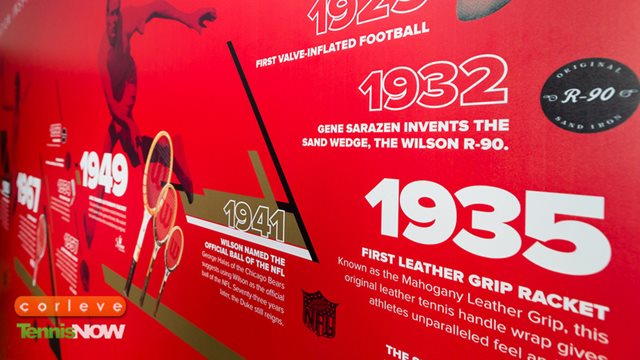By Lana Maciel / Wednesday, January 22, 2014
Wilson celebrates 100 years of playing a key role in influencing the game of tennis. The "100 Years Young" booth at the 2014 Australian Open illustrates how far the racquet business has come.
Photo credit: Mark Peterson/Corleve
Being a part of 500 Grand Slams is not an accomplishment very many can claim. But since 1914, Wilson has been at each of them, sharing more winning moments in the world of sports than perhaps any other company.
In honor of Wilson's 100th anniversary, the racquet company is on site at the 2014 Australian Open with a special booth to commemorate its rich history, complete with a display of the most notable and influential innovations that have helped shape the game of tennis over the past century.
 In addition to a timeline depicting key moments in Wilson's product creations, several vintage racquets - all in near mint condition, of course - sit proudly in display cases, evoking a nostalgia of an era that seems like another lifetime.
In addition to a timeline depicting key moments in Wilson's product creations, several vintage racquets - all in near mint condition, of course - sit proudly in display cases, evoking a nostalgia of an era that seems like another lifetime.
There's the 1949 Jack Kramer model, which was on the market for 35 years and is the most popular racquet in Wilson's history, and next to it sits the Tony Trabert and Chris Evert Autograph models. But these rare pieces appear to be an anomaly next to the rest of the collection on display.
Moving along the "timeline" of racquets, it is clear that Wilson was the catalyst that changed the game of tennis. And the biggest change came right around the time when the Open Era began.
After decades of creating a line of wooden racquets, Wilson produced the first steel racquet in 1967, the Wilson T2000. More than 2 million of these metal racquets were sold, and the model was used by players such as Billie Jean King and Jimmy Connors, who used the racquet's extra power to defeat Ken Rosewall (who wielded a wooden frame) in the 1974 Wimbledon final.
 And from the T2000, racquets morphed into models such as the Pro Staff, a frame made popular by tennis greats Pete Sampras and Stefan Edberg in 1983. Then came the Wilson Profile, the world's first wide-body frame, followed by the Sledge Hammer 3.4 Outer Limits, which boasted a 135-square-inch face and 29-inch length - the largest legal size for a racquet.
And from the T2000, racquets morphed into models such as the Pro Staff, a frame made popular by tennis greats Pete Sampras and Stefan Edberg in 1983. Then came the Wilson Profile, the world's first wide-body frame, followed by the Sledge Hammer 3.4 Outer Limits, which boasted a 135-square-inch face and 29-inch length - the largest legal size for a racquet.
It's a long road of history that leads to Wilson's latest technology development, the Spin Effect. Considering the importance of extra spin in today's power baseline game, the Spin Effect line of racquets features fewer cross strings, allowing players the ability to generate more than 200 RPMs of rotation on every shot for greater net clearance and more margin for error.
Clearly, today's game is a stark contrast to the game of the early 1900s when Thomas E. Wilson first established his sporting goods company. And Wilson's 100-year commemorative booth at the Australian Open illustrates not only the evolution of Wilson products, but more importantly, its pioneering role in the evolution of the game of tennis.
Where once players used wooden frames that were roughly 60 square inches, we now see graphite and metal sticks with about 30 more square inches on the racquet face. It's an eye-opening indication of how new technology and a larger frame have elevated the game to another level. And Wilson has helped shape that evolution every step of the way.